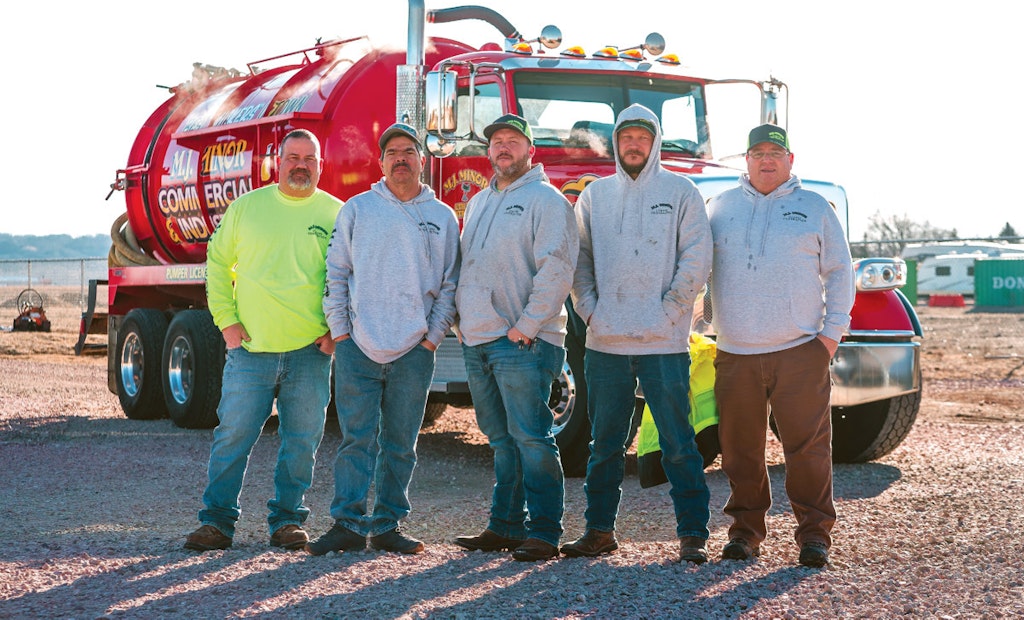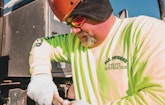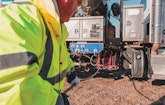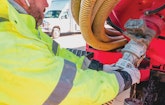
The crew at MJ Minor Utility Contractor includes, from left, Ted Ball Jr., Tony Verdin, Matt Bunce, Mark Bauer and Scott Jones. They are shown with a vacuum truck from Presvac Systems with an NVE blower. (Photos by Britton Hacke)
Interested in Industrial?
Get Industrial articles, news and videos right in your inbox! Sign up now.
Industrial + Get AlertsOne of the so-called “tri-state” areas in the U.S. is around Sioux City, Iowa, where the Missouri River and a tributary, the Big Sioux River, carve out jurisdictions, with one area called Iowa, another called South Dakota and a third, Nebraska. Whatever you call it, MJ Minor Utilities has it covered.
The contractor digs into the soils of the region using powerful hydroexcavators or, as needed, traditional excavation equipment. If a pipe or fiber optic line or other buried infrastructure is in the ground, MJ Minor can efficiently expose it for repair or replacement or simply to pinpoint its location for avoidance.
The company operates out of North Sioux City — the South Dakota community, not to be confused with South Sioux City, Nebraska or Sioux City in Iowa. The region is generically referred to as Siouxland and all of it constitutes the stomping ground for the 18-year-old company.
SOMETHING NEW
MJ Minor got into hydroexcavation after establishing itself as a traditional digging company. Launched in 2003, Minor focused on sewer, water and septic tank installations and repairs. It replaced fire hydrants and sewer laterals, digging into the soil to lay new infrastructure or fix the old.
The company still offers those services on commercial and residential properties as well as new construction projects. It maintains a fleet of equipment to do the work. Its CASE Construction machines include a 1650K dozer, two 821 wheel loaders, a CX210 excavator, two skid loaders and 660 trencher. A pair of Bobcat mini-excavators round out the earthmoving machinery. “CASE and Bobcat equipment have worked for us and we stay with them,” says Matt Bunce, shop foreman.
After five years of traditional utility excavation work, however, MJ Minor discovered hydroexcavation. “Nobody had seen anything like hydrovac,” says Scott Jones, general manager. “It was new; the company tried it and the work has been growing ever since.”
Jones wasn’t there when the company took to the new technology in 2008, joining the company in 2020. By the time he came aboard, hydrovac trucks came into their own as excavation tools.
MJ Minor quickly saw the future and expanded its fleet of equipment. Besides the traditional earthmoving machinery, the company’s five-acre equipment yard in North Sioux City now has a pair of pump trucks including “Big Red,” a 2020 Peterbilt industrial vacuum loader with a tilt bed/rear door. Parked there is a Spartan Ultimate Urban Warrior jetter mounted in a Ford 450 Transit cargo van. It can produce 12 gpm at 4,000 psi to clean sewer lines and storm sewers.
More to the point, the company has purchased two Vactor 2100 hydrovac trucks with 12-cubic-yard debris tanks and water pumps that can spew water at 2,500 psi at a rate of 80 gpm. These high-pressure water excavating machines — calling them examples of “cutting-edge technology” is almost a play on words — are used for a suite of services.
HARNESSING THE POWER
Each job involves moving dirt without threatening adjacent infrastructure. Ponderous as the trucks are, the working end of the hoses running from them are capable of removing packed earth with almost surgical precision, as Minor crew members have learned.
The surge of pressurized water blasting from the nozzle would seem a threat to old pipe or fiber optic lines, but operator care eliminates the risk of damaging vulnerable infrastructure. “I suppose if you directed a 2,000 psi flow against a line long enough, you could damage it,” Jones says. “We’ve never done so.”
Some of the more common uses of hydroexcavation in Siouxland are locating lines, digging holes for piles, creating service pits for work crews, slot trenching and blasting out test holes for directional drilling projects. “Locating a line is the job we most often are called to do,” says Jones, “or digging to find and fix one.”
The force which the 300 hp truck engines and pumps emit is considerable. MJ Minor’s Vactor 2100 trucks have cut 30 feet deep into the ground before the force and vacuum lift began to be spent. When faced with excavating a hole at a distance from a truck, MJ Minor has run a hose out 220 feet and successfully cut away and removed soil.
The general manager says he’s run into his share of surprises on calls. While some obstacles to an uneventful job are anticipated, others pop up. On one occasion, an MJ Minor crew went to a job site near a train station expecting to complete a trench cut in two days. However, fiber optic lines entered the picture and the crew spent two weeks removing dirt with both mechanical and hydrovac machines.
Having a variety of customers lets the company absorb slowdowns in one area or flex and accommodate a rush of work in another. Currently, jetting work on residential properties has slowed “for no particular reason,” says Jones, but hydroexcavation jobs continue to proliferate. They now account for 60% of the company’s business.
Industrial clients are a staple customer. These include a Tyson Foods plant, a GELITA USA gelatin production facility, a CF Industries ammonia manufacturing complex, a Royal Canin animal food facility and an AGP grain processing plant. Lines, pipes and disposal tanks are rife in the properties, and hydrovac solutions are regularly called upon. Municipal governments in the tri-state area also keep MJ Minor vac truck crews busy.
A VERSATILE TEAM
Jones has eight employees to help him with all this work. If not in the field, he is preparing bids and performing other administrative duties in the company’s office next to a 20,000-square-foot shop where Bunce works on machinery. Though major repairs to equipment are relegated to a manufacturer, Bunce performs routine maintenance.
“Keeping the equipment running smoothly is to our benefit and the customers’ benefit,” Bunce says. “We don’t have to worry about equipment breaking down and the customer doesn’t have to worry about a job being completed.”
MJ Minor crew members are cross-trained as much as possible. This means one of the experienced hands can climb on a mini-excavator and trench, push dirt with the dozer, or deftly control the potholing hose on a vac truck.
Jones says the versatility of the work holds the employees’ interest. The company does enjoy relative longevity among the crew, with employees being with the company three years, five years, eight years and so on, Jones says.
As elsewhere across the construction and heavy equipment industry, finding qualified people can be difficult. Jones says he is pleased with the people on payroll. “They are serious about their work. They go out and work together well all day.”
After the company hires good job applicants, it works hard to keep them, Jones says. “Once they are here, we bend over backward to see they have what they need to succeed. We have a good track record of keeping them and keeping them happy.”
It doesn’t hurt the morale of employees to know they will be periodically featured in a monthly downloadable newsletter. The Contractor’s Chronicle is sent to customers and potential clients. One issue of the Chronicle, for example, spotlights line locating and job site safety and shares a recipe of the month (“Waitin’-On-Turkey Stuffed Mushrooms”). It also features a brief Q&A with Tony Verdan, an 18-year MJ Minor employee.
DISCOVERING NEW TOOLS
This willingness to try new things and adapt to change has been codified in the company’s set of core values. One of them is titled, “Continuous Improvement.” It contains a pledge to pursue best practices and to “embrace new technologies that could make a project better.”
So, what new technology is the excavation and sewer-cleaning company looking into now? It turns out MJ Minor is considering investing in a new inspection camera for its pipeline work. The company is looking at buying an Envirosight Rovver X robotic camera for enhanced imaging of sewer mains.
New machines are fun, but in the end, capable equipment is only part of the equation that sustains the success of MJ Minor. Skilled workers and prompt response are key.
“We are there 24/7 to do the work, as needed,” Jones says. “Everyone knows when you call for emergency help in the middle of the night that it won’t be cheap, but our customers also know we are going to get the job done and that we’ll back it up.”











